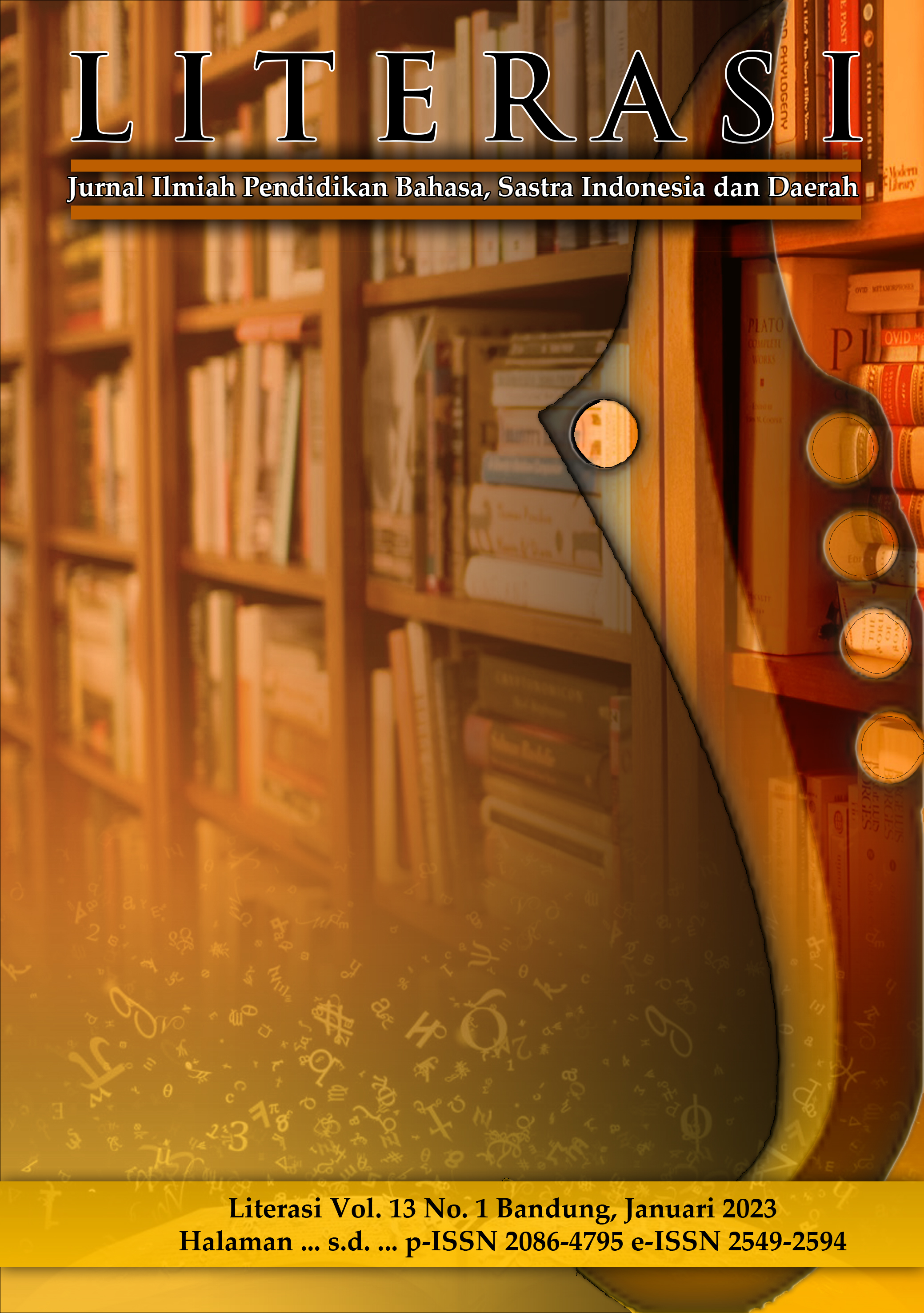DISFEMISME DAN FUNGSINYA DALAM KUMPULAN CERPEN SaiA KARYA DJENAR MAESA AYU
DOI:
https://doi.org/10.23969/literasi.v13i1.6829Keywords:
Dysphemism, Function, Collection of Short StoriesAbstract
The study is attracted by freedom of opinion is misused in communication activities by using words that have harsh meanings, giving rise to negative feelings. The research aims to find out the forms and functions of dysphemism in Djenar Maesa Ayu's short story collection SAiA. The research data in the form of words and phrases were obtained from the utterances of the characters in the story which contain elements of dysphemism. Data collection used the document technique, through the corpus linguistic method, namely the Indonesian Archipelago Corpus (KORTARA). Triangulation technique is used in validating research data. Research data analysis techniques include categorization, tabulation, and interpretation with substitution techniques to find agreement and differences in euphemism as a form of replacement. The findings show that there are eight forms of dysphemism and the most used form is the use of everyday technical terms, the other seven forms are the use of technical terms and jargon, figurative expressions (figuratively speaking), similes, circumlocutions, metaphors, clippings. (clipping), and hyperbole (hyperbola); Dysphemism in Djenar Maesa Ayu's collection of short stories SAiA functions as an expression to hide other people, to show dislike, to give a negative description of political actors, to express anger or annoyance, to reveal quarrels, and to amplify or exacerbate insults
Downloads
References
Allan, K., & Burridge, K. (1991). Euphemism and Dysphemism Language Used As Shield and Weapon. Oxford University Press.
Ayu, W., Aziza, A. N., Kusuma, A., & Nurul, I. (2021). Disfemisme Pada Kolom Komentar Akun Instagram @rahmawatikekeyiputricantikka 23. 106–130. https://doi.org/10.21776/ub.hastawiyata.2021.004.02.02
Chaer, A. (2009). Pengantar Semantik Bahasa Indonesia. Rineka Cipta.
Jayanti, Rezeli, R., Maulida, N., & Musdolifah, A. (2018). Eufemisme dan Disfemisme Pada Judul Berita Surat Kabar Harian Balikpapan Pos Periode April-Mei 2018. 2(1), 77–86.
Mahsun. (2007). Metode Penelitian Bahasa. Raja Grafindo Persada.
Moleong, L. J. (2009). Metodologi Penelitian Kualitatif. PT Remaja Rosdakarya.
Nadja, N. (2011). Corpus Linguistics: A Practical Introduction.
Pateda. (2010). Semantik Leksikal. Rineka Cipta.
Puspita, A. N. (2021). Bentuk Disfemisme dalam Kolom Komentar Video Trending Youtube Pasca Pemilihan Umum 2019. Nuansa Indonesia, 23(2), 160–172.
Reistanti, P. (2022). DISFEMIA DALAM AKUN INSTAGRAM. 20, 21–32.
Ristanto, B. (2019). Efek Penggunaan Disfemia Dalam Teks Media. 3, 161–172.
Sagala, L. H. U. B. (2019). Kajian Eufemisme dan Disfemisme Pada Komentar Para Netizen Dalam YouTube Berita Kumparan.com (Edisi Menko Polhukam Wiranto Ditusuk Orang di Pandeglang). Prosiding Seminar Internasional Riksa Bahasa XIII, 539–548.
Saputri, V., Ramadhan, S., & Asri, Y. (2019). Eufemisme dan Disfemisme Dalam Novel “Korupsi” Karya Pramoedya Ananta Toer. 198–207. https://doi.org/10.26858/retorika.v12i2.9149
Sudaryanto. (1993). Metode dan Aneka Teknik Analisis Bahasa. Duta Wacana University Press.
Ulfatin. (2014). Metode Penelitian Kualitatif di Bidang Pendidikan: Teori dan Aplikasinya. (Malang). Bayumedia Publishing.
Wiyatmi. (2017). Ekofeminisme: Kritik Sastra Berwawasan Ekologis dan Feminis. Cantrik Pustaka.
Zollner. (1997). Der Euphemismus im Alltaglichen und Politischen Sprachgebrauch des Englischen. Peter Lang GmbH.
Downloads
Published
Issue
Section
License
Copyright (c) 2023 Literasi: Jurnal Ilmiah Pendidikan Bahasa, Sastra Indonesia dan Daerah

This work is licensed under a Creative Commons Attribution 4.0 International License.
Hak cipta artikel yang diterbitkan di jurnal ilmiah dimiliki oleh penerbit, bukan penulis. Hal ini berkaitan dengan koordinasi hak akses untuk cetak ulang atau penggunaan lainnya. Dalam hal ini penerbit mempunyai keluluasaan untuk mempublikasikan artikel sesuai dengan kesepakanan Transfer Agreement (penyerahan hak cipta) antara penerbit dengan penulis.















